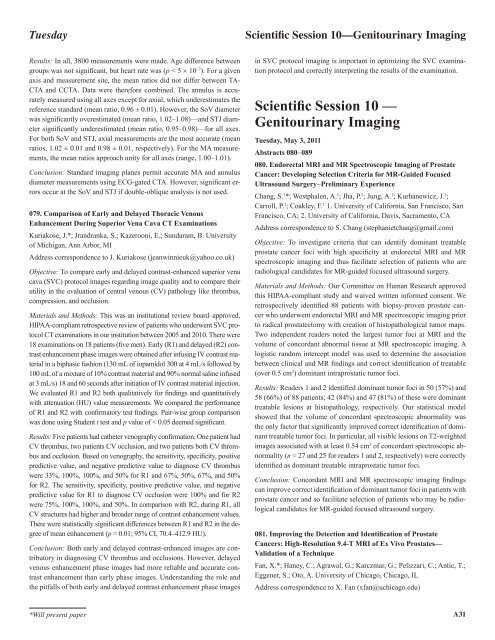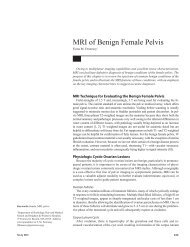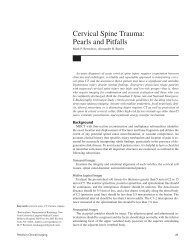Scientific Session 1 â Breast Imaging: Mammography
Scientific Session 1 â Breast Imaging: Mammography
Scientific Session 1 â Breast Imaging: Mammography
You also want an ePaper? Increase the reach of your titles
YUMPU automatically turns print PDFs into web optimized ePapers that Google loves.
Tuesday<strong>Scientific</strong> <strong>Session</strong> 10—Genitourinary <strong>Imaging</strong>Results: In all, 3800 measurements were made. Age difference betweengroups was not significant, but heart rate was (p < 5 × 10 –7 ). For a givenaxis and measurement site, the mean ratios did not differ between TA-CTA and CCTA. Data were therefore combined. The annulus is accuratelymeasured using all axes except for axial, which underestimates thereference standard (mean ratio, 0.96 ± 0.01). However, the SoV diameterwas significantly overestimated (mean ratio, 1.02–1.08)—and STJ diametersignificantly underestimated (mean ratio, 0.95–0.98)—for all axes.For both SoV and STJ, axial measurements are the most accurate (meanratios, 1.02 ± 0.01 and 0.98 ± 0.01, respectively). For the MA measurements,the mean ratios approach unity for all axes (range, 1.00–1.01).Conclusion: Standard imaging planes permit accurate MA and annulusdiameter measurements using ECG-gated CTA. However, significant errorsoccur at the SoV and STJ if double-oblique analysis is not used.079. Comparison of Early and Delayed Thoracic VenousEnhancement During Superior Vena Cava CT ExaminationsKuriakose, J.*; Jrandranka, S.; Kazerooni, E.; Sundaram, B. Universityof Michigan, Ann Arbor, MIAddress correspondence to J. Kuriakose (jeanwinnieuk@yahoo.co.uk)Objective: To compare early and delayed contrast-enhanced superior venacava (SVC) protocol images regarding image quality and to compare theirutility in the evaluation of central venous (CV) pathology like thrombus,compression, and occlusion.Materials and Methods: This was an institutional review board–approved,HIPAA-compliant retrospective review of patients who underwent SVC protocolCT examinations in our institution between 2005 and 2010. There were18 examinations on 18 patients (five men). Early (R1) and delayed (R2) contrastenhancement phase images were obtained after infusing IV contrast materialin a biphasic fashion (130 mL of iopamidol 300 at 4 mL/s followed by100 mL of a mixture of 10% contrast material and 90% normal saline infusedat 3 mL/s) 18 and 60 seconds after initiation of IV contrast material injection.We evaluated R1 and R2 both qualitatively for findings and quantitativelywith attenuation (HU) value measurements. We compared the performanceof R1 and R2 with confirmatory test findings. Pair-wise group comparisonwas done using Student t test and p value of < 0.05 deemed significant.Results: Five patients had catheter venography confirmation. One patient hadCV thrombus, two patients CV occlusion, and two patients both CV thrombusand occlusion. Based on venography, the sensitivity, specificity, positivepredictive value, and negative predictive value to diagnose CV thrombuswere 33%, 100%, 100%, and 50% for R1 and 67%, 50%, 67%, and 50%for R2. The sensitivity, specificity, positive predictive value, and negativepredictive value for R1 to diagnose CV occlusion were 100% and for R2were 75%, 100%, 100%, and 50%. In comparison with R2, during R1, allCV structures had higher and broader range of contrast enhancement values.There were statistically significant differences between R1 and R2 in the degreeof mean enhancement (p = 0.01; 95% CI, 70.4–412.9 HU).Conclusion: Both early and delayed contrast-enhanced images are contributoryin diagnosing CV thrombus and occlusions. However, delayedvenous enhancement phase images had more reliable and accurate contrastenhancement than early phase images. Understanding the role andthe pitfalls of both early and delayed contrast enhancement phase imagesin SVC protocol imaging is important in optimizing the SVC examinationprotocol and correctly interpreting the results of the examination.<strong>Scientific</strong> <strong>Session</strong> 10 —Genitourinary <strong>Imaging</strong>Tuesday, May 3, 2011Abstracts 080-089080. Endorectal MRI and MR Spectroscopic <strong>Imaging</strong> of ProstateCancer: Developing Selection Criteria for MR-Guided FocusedUltrasound Surgery-Preliminary ExperienceChang, S. 1 *; Westphalen, A. 1 ; Jha, P. 2 ; Jung, A. 1 ; Kurhanewicz, J. 1 ;Carroll, P. 1 ; Coakley, F. 1 1. University of California, San Francisco, SanFrancisco, CA; 2. University of California, Davis, Sacramento, CAAddress correspondence to S. Chang (stephanietchang@gmail.com)Objective: To investigate criteria that can identify dominant treatableprostate cancer foci with high specificity at endorectal MRI and MRspectroscopic imaging and thus facilitate selection of patients who areradiological candidates for MR-guided focused ultrasound surgery.Materials and Methods: Our Committee on Human Research approvedthis HIPAA-compliant study and waived written informed consent. Weretrospectively identified 88 patients with biopsy-proven prostate cancerwho underwent endorectal MRI and MR spectroscopic imaging priorto radical prostatectomy with creation of histopathological tumor maps.Two independent readers noted the largest tumor foci at MRI and thevolume of concordant abnormal tissue at MR spectroscopic imaging. Alogistic random intercept model was used to determine the associationbetween clinical and MR findings and correct identification of treatable(over 0.5 cm 3 ) dominant intraprostatic tumor foci.Results: Readers 1 and 2 identified dominant tumor foci in 50 (57%) and58 (66%) of 88 patients; 42 (84%) and 47 (81%) of these were dominanttreatable lesions at histopathology, respectively. Our statistical modelshowed that the volume of concordant spectroscopic abnormality wasthe only factor that significantly improved correct identification of dominanttreatable tumor foci. In particular, all visible lesions on T2-weightedimages associated with at least 0.54 cm 3 of concordant spectroscopic abnormality(n = 27 and 25 for readers 1 and 2, respectively) were correctlyidentified as dominant treatable intraprostatic tumor foci.Conclusion: Concordant MRI and MR spectroscopic imaging findingscan improve correct identification of dominant tumor foci in patients withprostate cancer and so facilitate selection of patients who may be radiologicalcandidates for MR-guided focused ultrasound surgery.081. Improving the Detection and Identification of ProstateCancers: High-Resolution 9.4-T MRI of Ex Vivo Prostates—Validation of a TechniqueFan, X.*; Haney, C.; Agrawal, G.; Karczmar, G.; Pelizzari, C.; Antic, T.;Eggener, S.; Oto, A. University of Chicago, Chicago, ILAddress correspondence to X. Fan (xfan@uchicago.edu)*Will present paperA31
















